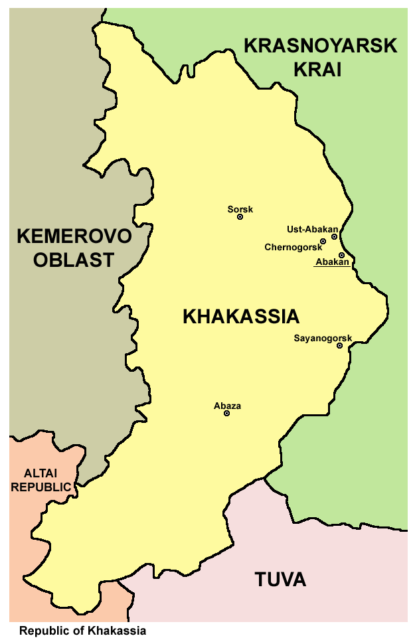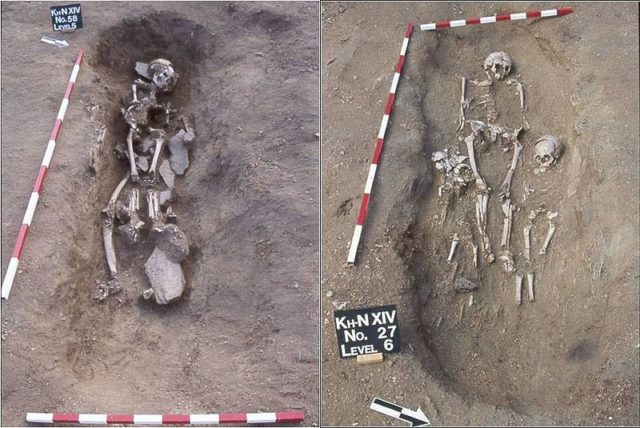The treasure found in the Noblewoman’s grave included an incense burner that was decorated by solar symbols, 1500 beads that adorned her costume, and 100 pendants that had been created from animal teeth.
The interesting discovery of the Noblewoman from the ancient Okunev culture was made in the Republic of Khakassia.

The Okunev people appear as the Siberian ethnic grouping that was most closely related to Native Americans. Specifically, they were the ancestors of the Okunevs who once populated America, apparently using prehistoric boats to venture to the ice-covered Beringia land bridge around 12,600 years ago. This mysterious ancient culture was exceptional in Siberia in terms of its artistic richness and diversity, according to specialists.
The grave was not disturbed by pillaging grave robbers. The burial site of the woman also contained the remains of a child. It offered a wealth of clues about the life of these ancient individuals.
The head archaeologists of the expedition stated the grave of this noblewoman dated back to the Early Bronze Age, during the time of the 25th and 18th centuries BC.
For such an ancient period, this woman still had lots of items in her grave. Archaeologists have not encountered anything like this in other burial chambers from this time. It guides them to suggest that the objects in her grave had some kind of ritual meaning.
They are hoping this year will lead to even more interesting discoveries, and will continue to study this unique surface and open the central burial site. Archaeologists believe that the woman had enjoyed a special status throughout her life.
This is indicated by the 100 decorations created from the teeth of various animals. Some items were carved from horns and bones. Also found were a bronze knife, cases with bone needles inside, and two jars. More than 1,500 beads decorated her funeral costume.

There was particular excitement about an incense burner found in the site, which contained faces that match previously found ancient rock art in Siberia – the clay incense burner had three sun-shaped facial images. Archaeologists feel that this was the most significant discovery of them all.
The importance of this item to archaeologists is huge. All the pictures previously found had been seen only on cliffs or separate stones. Now archaeologists have a way to discover when they were created.
Archaeologists have made clear that, thanks to their current research, they can confirm this rock art was created by a representative of the Okenuv people. After being precisely dated and restored, the incense burner will be put on public display at the world famous Heritage Museum located in St. Petersburg.
Another find is a stone slab with an uncommon picture of a bull with a long rectangular body. These are not known to be common in southern Siberia, yet are known in the region of modern Kazakhstan. Archaeologists now see this as an indication that the Okunev people might have moved to Khassia from the south.
Now does this mean that modern Native Americans originated from Kazakhstan and not southern Siberia, as we had previously thought? More scientific evidence is waiting to be discovered.
There are stone roofs attached to several graves on the burial hill at Itkol II, that also have chiseled pictures similar to the Okunev faces.
Archaeologists believe that they are not faces of actual people, but more likely pictures of gods, spirits, and other supernatural deities. One of the faces is a kind that has never been seen before, details of this discovery have not been made public so far.
This culture owes it name to the locality of the Okunev, in the south of Khakassia. This is where the first burial location of this kind was excavated in 1928. Okunev steles, stone columns that are several meters tall, are the most widely noted monument attributed to this culture.
The top of these steles has the form of a bird’s beak. The middle portion is decorated with pictures of one or many god-like creatures, while the lower portion resembles the open mouth of a snake. Specialists see this as proof of the sophistication of these peoples’ faith, and that they were convinced the world surrounding them consisted of three major elements.

The Okunev culture is a unique phenomenon of the Early Bronze Age of Southern Siberia.
Archaeologists have found a large quantity of artistic heritage in the form of several images, like masks that have been engraved, or carvings in the rocks. This culture had their own special style, a type of symbol for them.
About two years ago, a Siberian angler Nikolay Tarasov, at that time 53-years old, was fishing for carp. Instead he pulled out of the water a 4,000 year old pagan god statuette carved into a horn that was later fossilized.
This figurine had almond-shaped eyes, a big mouth with full lips, and a ferocious facial expression. This discovery was thought to have been from the Okunev culture. Could this artifact really be from the Okenev culture?
https://www.youtube.com/watch?v=lNqlc8-RRy8&feature=youtu.be
